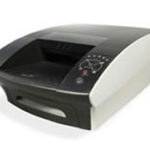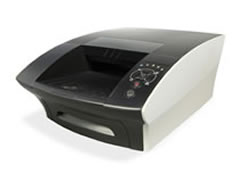
For a long time, the two choices in desktop printers have been inkjet and laser. This year, a significant twist on the inkjet is hitting the market and promises higher color printing speeds—think one color page per second—at a relatively low cost.
The company behind the new technology, Memjet, hopes to snag a significant share of the $250 billion-per-year worldwide printing market.
“We’re bringing revolutionary change to the industry,” said Len Lauer, Memjet’s CEO.
Memjet can be several times faster than a regular inkjet printer, because instead of having a small print head that sweeps across the page, over and over, Memjet’s head is as wide as the page and doesn’t move.
As the paper travels underneath it, 70,000 microscopic nozzles spurt ink all at the same time.
High-end laser printers can match Memjet’s speed but they cost more, both to buy and to use. Lauer expects Memjet-equipped printers to hit the market this year for $500 to $600. The ink will cost about 5 cents per page, compared with 12 cents to 25 cents per page for laser toner or consumer inkjet ink.
The page-wide heads and tiny nozzles are made possible by advances in micro-electro-mechanical systems, or MEMS. These are parts made out of silicon using many of the same techniques that go into making computer chips, so manufacturers can create tiny and very precise mechanical assemblies.
MEMS are also used in digital cinema projectors and in the sensors that capture the motion of the Nintendo Wii’s remotes and such smart phones as the iPhone.
Other companies have demonstrated wide inkjet heads, but Memjet appears to be the first to make it a finished desktop product.
The inventor of the Memjet head is Kia Silverbrook, an Australian, but the privately held company is based in San Diego. Lauer comes from another San Diego-based company, wireless technology developer Qualcomm Inc., where he was chief operating officer.
The first Memjet printer for the office market will be sold by computer maker Lenovo Corp. in China early this year and by other partners in Taiwan and India, the companies announced last week.
Memjet hasn’t announced a partner for the U.S., but Lauer said the printer would be sold here this year as well.
In a demonstration last week at the International Consumer Electronics Show in Las Vegas, a prototype of the Memjet printer churned out color pages, one per second, of a quality indistinguishable from a good inkjet printer.
“It’s a disruptor in that it’s very fast for a very low price,” said Keith Kmetz, a printing industry analyst for IDC. The Memjet technology “has had the market abuzz,” he said, but he added that there’s more to market success than technology. Memjet still has to prove that its partners can market the printers effectively.
Memjet has talked about its color printing technology for years while it straightened out some kinks, so it won’t catch well-established players such as Hewlett-Packard Co., Lexmark International Inc., and Canon Inc. by surprise.
“I haven’t noticed in my conversations with them that they’re gravely concerned,” Kmetz said.
Memjet isn’t targeting individual consumers with its printers, at least for now.
The home printer market is even tougher than the office market, because manufacturers such as HP subsidize their products heavily, then make the money back from sales of ink cartridges. Fast color printing also isn’t as important to consumers, who are printing less and toting more information and pictures around on their smart phones.
Memjet is targeting commercial printing applications, such as photo finishing, with a unit that prints page-wide glossy photos. The goal is to replace drugstore minilab prints, which are still mostly created using light-sensitive paper and noxious chemicals. Memjet’s unit is smaller, cheaper, and faster.
Prints from a prototype shown last week weren’t as vividly colored as regular minilab prints, but Lauer said the technology is still being tweaked.
Label printers with Memjet’s heads are already in use. This means that a company such as FedEx Corp., for example, which prints millions of barcode labels every day, could now add color to them, perhaps for its logo or other information that should stand out, Lauer said.
The technology also could be used in cash registers, which would let retailers print out coupons in color on receipts. However, the 8.5-inch wide Memjet head is too broad for a cash register, so Memjet would have to make a smaller one.
One customer, Lauer said, uses the label printer to print tens of thousands of personally addressed direct-mail envelopes every day, without needing to pre-print the color with standard, high-volume “offset” printing.
“Yes, you can now get your junk mail in color,” Lauer said.
- Research: Social media has negative impact on academic performance - April 2, 2020
- Number 1: Social media has negative impact on academic performance - December 31, 2014
- 6 reasons campus networks must change - September 30, 2014
